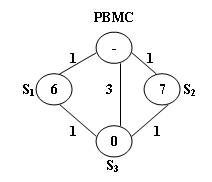1018 Public Bike Management (30 分)
There is a public bike service in Hangzhou City which provides great convenience to the tourists from all over the world. One may rent a bike at any station and return it to any other stations in the city.
The Public Bike Management Center (PBMC) keeps monitoring the real-time capacity of all the stations. A station is said to be in perfect condition if it is exactly half-full. If a station is full or empty, PBMC will collect or send bikes to adjust the condition of that station to perfect. And more, all the stations on the way will be adjusted as well.
When a problem station is reported, PBMC will always choose the shortest path to reach that station. If there are more than one shortest path, the one that requires the least number of bikes sent from PBMC will be chosen.
The above figure illustrates an example. The stations are represented by vertices and the roads correspond to the edges. The number on an edge is the time taken to reach one end station from another. The number written inside a vertex S is the current number of bikes stored at S. Given that the maximum capacity of each station is 10. To solve the problem at S3, we have 2 different shortest paths:
- PBMC -> S1 -> S3. In this case, 4 bikes must be sent from PBMC, because we can collect 1 bike from S1 and then take 5 bikes to S3, so that both stations will be in perfect conditions.
- PBMC -> S2 -> S3. This path requires the same time as path 1, but only 3 bikes sent from PBMC and hence is the one that will be chosen.
Input Specification:
Each input file contains one test case. For each case, the first line contains 4 numbers: Cma**x (≤100), always an even number, is the maximum capacity of each station; N (≤500), the total number of stations; S**p, the index of the problem station (the stations are numbered from 1 to N, and PBMC is represented by the vertex 0); and M, the number of roads. The second line contains N non-negative numbers C**i (i=1,⋯,N) where each C**i is the current number of bikes at S**i respectively. Then M lines follow, each contains 3 numbers: S**i, S**j, and Tij which describe the time Tij taken to move betwen stations S**i and S**j. All the numbers in a line are separated by a space.
Output Specification:
For each test case, print your results in one line. First output the number of bikes that PBMC must send. Then after one space, output the path in the format: 0−>S1−>⋯−>S**p. Finally after another space, output the number of bikes that we must take back to PBMC after the condition of S**p is adjusted to perfect.
Note that if such a path is not unique, output the one that requires minimum number of bikes that we must take back to PBMC. The judge’s data guarantee that such a path is unique.
Sample Input:
1 | 10 3 3 5 |
Sample Output:
1 | 3 0->2->3 0 |
作者: CHEN, Yue
单位: 浙江大学
时间限制: 400 ms
内存限制: 64 MB
代码长度限制: 16 KB
题目大意
杭州有多个自行车站点,以及一个管理站。当站点的自行车数量是最大容量的1/2是,该站点是“平衡“的。给出问题站,管理站需要以最短的路径到达问题站,并把沿途的站点都设置为平衡的。如果有多条路径,则选择需要从站点带出自行车最少的路径,如果仍有多条,选择带回自行车最少的路径。输出带出的自行车数、路径、带回的自行车数
分析
dijkstra+dfs。首先使用dijkstra计算管理站到问题站点的最短路径,使用vector<int>数组纪录各个站点的前序站点。然后从问题站开始dfs回出发站,计算沿途需要调整的自行车数。这里的逻辑具体为:
1.使用back纪录带回的自行车数。当一个站点的权重为正,说明有多余自行车需带回,加至back中。
2.如果权重为负,需要补充自行车,首先从back中补充,若不够则需从管理站带出。
代码
1 |
|
其他
这里必须使用dijkstra+dfs。仅一次dijkstra无法得到结果,因为路径上的需调整自行车数不满足最优子结构。必须先选出路径,然后dfs比较。

